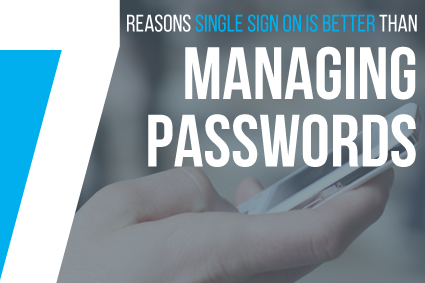Single sign-on, as explained in a previous Avatier article, “utilizes just one set of login credentials to access multiple applications. This type of authentication process is a response to the growing number of user accounts and the shift towards cloud technology.”
Because the average number of passwords per person has grown from 6.5 in 2007 to 27 in 2016, it’s no surprise that users are searching for ways to streamline their logins. And that’s what SSO is exactly for. Instead of entering a username and password for each account, “SSO streamlines logins so users only need to enter their login credentials one time in order to get access to their many accounts.”
That may sound intriguing, but is SSO really that much better than just managing passwords? Absolutely.
1. SSO reduces help desk costs.
SSO saves users from having to memorize multiple passwords. How does that translate into costs?
According to Gartner, up to 50% of all help desk calls are just requests for password resets. Depending on the rate of your support calls, Forrester adds that each password reset can amount to $70.
That means the more users you have, the higher your help desk costs will be. Additionally, in order to counter rising security threats to data, companies are implementing stronger and more complex security policies. This includes using stronger passwords that are longer and contain a combination of uppercase and lowercase letters, numbers, and even non-alphanumeric characters.
Because of the length and complexity, even a single password can be pretty much impossible to recall. To make matters worse, most users are required to access anywhere between 5 and even 20 applications per day. When there are more passwords to remember, people are more likely to forget.
With SSO, users only have to remember one or a very few number of passwords. The result is that SSO will reduce forgotten passwords and ultimately lower your help desk costs.
2. SSO boosts productivity.
If your company is implementing a strict password policy, then a simple login process can take longer than usual. That’s because users will have to find the specific password on their password list and then enter each character into the password field. If the login fails, they’ll have to see if they missed a character or double-check to see which character was keyed in incorrectly.
And if they fail more than three times? They’ll probably have to contact the help desk and request a password reset. That’s obviously going to eat into their valuable time, which could be spent on more productive activities.
When they only have to remember one password, they can significantly reduce login time, as well as decrease the chances of a failed login.
3. SSO strengthens security compliance.
One misconception about SSO is that because it reduces the characters of a password, it will weaken security. However, because users only have to remember one password, that password will be stronger. And they’ll be less likely to share that password with others.
Additionally, SSO can help strengthen security and compliance by encouraging users to use security applications, such as a secure file transfer system. Secure file transfer systems are an essential component in industries that are governed by regulations like HIPAA and PCI-DSS, as they must protect transmissions of sensitive data.
The problem is that most security programs like these are underutilized because users find them complicated. SSO can remove some of these complexities and encourage more user buy-in.
4. SSO facilitates B2B collaboration.
Believe it or not, SSO also plays a critical role in bringing about B2B collaboration. Everything from phones to computers, movies, and cars are built through a collaborative effort between partnering enterprises.
This kind of working environment is called interoperability. Because of this collaborative effort, the sharing of data, digital tools, and interactive programs via extranets is needed to build a more measurable output, along with consumer confidence. Because time is of the essence, SSO is key to facilitating B2B collaboration where every player can exchange data seamlessly and securely with each other.
5. SSO improves customer satisfaction.
Never underestimate the power of a great user experience. Both your employees and partners want and demand it. SSO can improve customer satisfaction by making the login process quick and simple. Remember, the login screen is usually the first interaction between users and your website. If it’s too complicated, users will get frustrated and jump ship to a competitor.
Furthermore, SSO allows for your business to use identify management to create a more tailor-made experience for your customers. For example, if you were a brick-and-mortar retailer and a customer logged in to check in on Facebook, you could offer discounts or promotions that the specific user wants.
6. SSO helps leverage mobile.
Mobile devices are becoming the preferred devices for users. As such, users expect secure and seamless mobile access to business-critical applications and resources. If not, you’ll be missing out on both revenue from your customers and productivity from your employees.
Start by extending SSO to mobile users so they can use the same password for their mobile devices and desktops.
7. You don’t have to outsource data.
What happens if you’re working with a third-party application that is managing employee data? That means it’s in charge of retrieving or resetting those credentials. Now your IT team not only has to help your employees, but it also has to contact the third party for the information.
SSO lets the third party use the credentials you already manage and control, thereby removing the need for your support team to get involved with any third party.
Conclusion
Is SSO the end-all of online security measures? Unfortunately, no.
But if you’re looking to save money, increase productivity, strengthen security, tighten B2B collaboration, and improve the customer experience, then SSO is both a timely and effective solution to a sizable issue.
Sources
https://blog.avatier.com/how-single-sign-on-works/
http://www.gartner.com/newsroom/id/1426813
http://www.mandylionlabs.com/PRCCalc/PRCCalc.htm
https://blog.avatier.com/keeping-your-ducks-in-a-row-managing-governance-risk-and-compliance/




